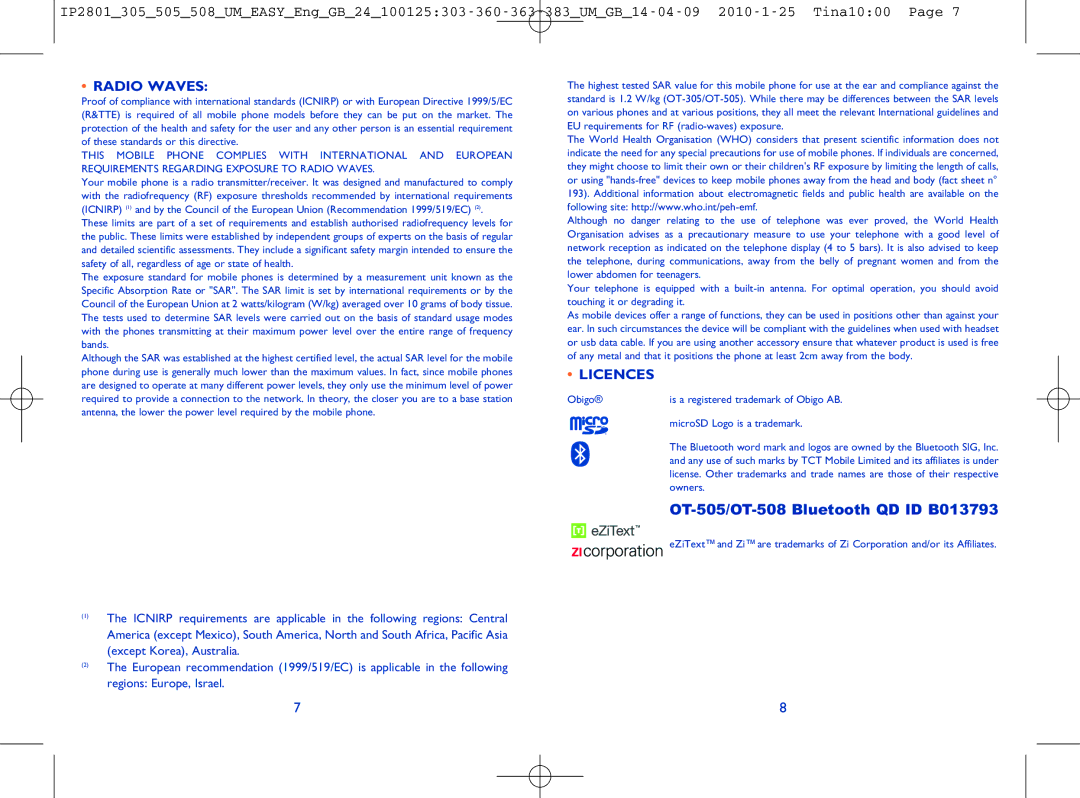
• RADIO WAVES:
Proof of compliance with international standards (ICNIRP) or with European Directive 1999/5/EC (R&TTE) is required of all mobile phone models before they can be put on the market. The protection of the health and safety for the user and any other person is an essential requirement of these standards or this directive.
THIS MOBILE PHONE COMPLIES WITH INTERNATIONAL AND EUROPEAN REQUIREMENTS REGARDING EXPOSURE TO RADIO WAVES.
Your mobile phone is a radio transmitter/receiver. It was designed and manufactured to comply with the radiofrequency (RF) exposure thresholds recommended by international requirements (ICNIRP) (1) and by the Council of the European Union (Recommendation 1999/519/EC) (2).
These limits are part of a set of requirements and establish authorised radiofrequency levels for the public. These limits were established by independent groups of experts on the basis of regular and detailed scientific assessments. They include a significant safety margin intended to ensure the safety of all, regardless of age or state of health.
The exposure standard for mobile phones is determined by a measurement unit known as the Specific Absorption Rate or "SAR". The SAR limit is set by international requirements or by the Council of the European Union at 2 watts/kilogram (W/kg) averaged over 10 grams of body tissue. The tests used to determine SAR levels were carried out on the basis of standard usage modes with the phones transmitting at their maximum power level over the entire range of frequency bands.
Although the SAR was established at the highest certified level, the actual SAR level for the mobile phone during use is generally much lower than the maximum values. In fact, since mobile phones are designed to operate at many different power levels, they only use the minimum level of power required to provide a connection to the network. In theory, the closer you are to a base station antenna, the lower the power level required by the mobile phone.
The highest tested SAR value for this mobile phone for use at the ear and compliance against the standard is 1.2 W/kg
The World Health Organisation (WHO) considers that present scientific information does not indicate the need for any special precautions for use of mobile phones. If individuals are concerned, they might choose to limit their own or their children's RF exposure by limiting the length of calls, or using
Although no danger relating to the use of telephone was ever proved, the World Health Organisation advises as a precautionary measure to use your telephone with a good level of network reception as indicated on the telephone display (4 to 5 bars). It is also advised to keep the telephone, during communications, away from the belly of pregnant women and from the lower abdomen for teenagers.
Your telephone is equipped with a
As mobile devices offer a range of functions, they can be used in positions other than against your ear. In such circumstances the device will be compliant with the guidelines when used with headset or usb data cable. If you are using another accessory ensure that whatever product is used is free of any metal and that it positions the phone at least 2cm away from the body.
• LICENCES
Obigo® | is a registered trademark of Obigo AB. |
| microSD Logo is a trademark. |
| The Bluetooth word mark and logos are owned by the Bluetooth SIG, Inc. |
| and any use of such marks by TCT Mobile Limited and its affiliates is under |
| license. Other trademarks and trade names are those of their respective |
| owners. |
|
|
eZiText™and Zi™are trademarks of Zi Corporation and/or its Affiliates.
(1) | The ICNIRP requirements are applicable in the following regions: Central |
|
| America (except Mexico), South America, North and South Africa, Pacific Asia |
|
| (except Korea), Australia. |
|
(2) | The European recommendation (1999/519/EC) is applicable in the following |
|
| regions: Europe, Israel. | 8 |
| 7 |
